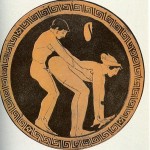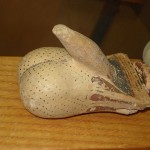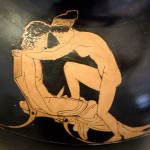Rowdy taverns feature prominently in Greek literature, but there haven’t been any actual confirmed taverns found. A researcher at the University of Leeds thinks she’s figured out why.
She reviewed archaeolgoical remains unearthed at several prominent sites dating from 475 to 323 BC, including the Villa of Good Fortune in Olynthus, and a residence known as building Z in Athens.
To many archaeologists, the vast numbers of mugs, erotic graffiti and objects found at the sites indicate no more than well-off families that threw lavish parties. But Kelly Blazeby will tell the Archaeological Institute of America meeting in Philadelphia this week that a more plausible explanation is that residents turned over rooms in their houses to selling wine, gambling and even prostitution.
“If you look at the remains coming from ancient Greek homes, it seems very clear to me that these buildings had another function, that some areas were used for commercial purposes,” she said.
It’s seems a reasonable interpretation to me. Even a wealthy home doesn’t have much need for hundreds of drinking vessels, never mind the cubicles that surrounded the cup room. OMG champagne room before champagne!
Anyway, Google tells me that one of the homes in question, Building Z, is already being marketed to tourists as a brothel, so not everyone finds the theory controversial.
And now because what’s a story about a bawdy-house without some bawd, here are some Greek erotic objects from random times and places.


